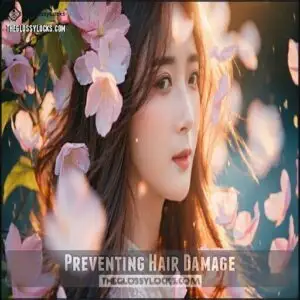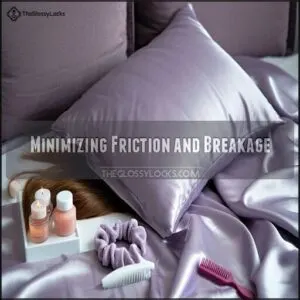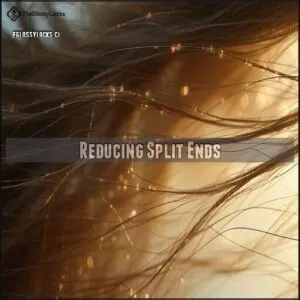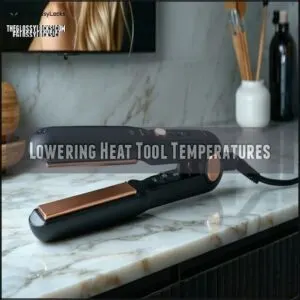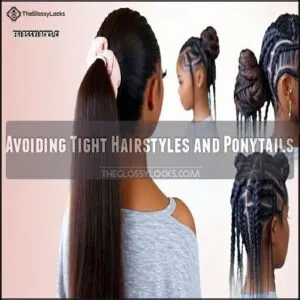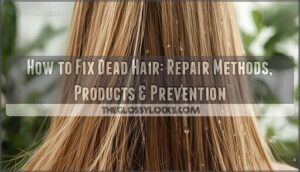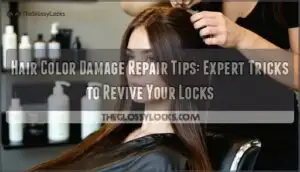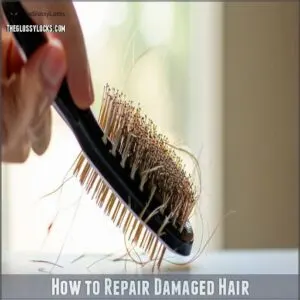This site is supported by our readers. We may earn a commission, at no cost to you, if you purchase through links.

Protect your hair from sun and pollution by wearing a hat or using products with UV filters. Stick to regular trims to keep split ends in check.
Avoid tight hairstyles that pull on your strands and swap harsh towel drying for a soft microfiber towel. Balanced nutrition, hydration, and managing stress also go a long way in keeping your hair strong.
Table Of Contents
- Key Takeaways
- Preventing Hair Damage
- Hair Care Routine Tips
- Reducing Split Ends
- Healthy Hair Styling Habits
- Long-Term Hair Health Strategies
- Frequently Asked Questions (FAQs)
- How can I prevent hair damage?
- What can be done to stop hairfall at an early age?
- How do you prevent hair breakage?
- What can I do if my hair is damaged?
- How can I protect my hair from sun damage?
- How to prevent hair loss?
- Can you prevent future hair loss?
- What are the big 3 to prevent hair loss?
- How do you fix damaged hair years?
- How can I protect my long hair from damage?
- Conclusion
Key Takeaways
- Limit heat styling tools and always use heat protectants when styling—lower temperature settings on your tools and consider alternatives like air drying or loose braids to give your hair a break from heat damage.
- Handle wet hair gently by using wide-tooth combs and microfiber towels—start detangling from the ends working upward and pat your hair dry instead of rubbing to reduce friction and breakage.
- Protect your hair from environmental factors by wearing hats or using products with UV filters when outdoors, and rinse with fresh water before swimming to minimize chlorine exposure.
- Maintain a balanced diet rich in proteins, essential fatty acids, and vitamins—what you eat directly impacts your hair health, so stay hydrated and manage stress for stronger, more resilient hair.
Preventing Hair Damage
To prevent hair damage, focus on protecting your strands from heat, harsh chemicals, and environmental stress.
Protect your hair by minimizing heat, avoiding harsh chemicals, and shielding it from environmental stress for long-lasting health.
Simple changes like lowering heat tool settings and using gentle products can make a big difference over time.
Avoiding Excessive Heat Styling
To prevent hair heat damage, lower temperatures on styling tools and always use heat protectants.
Lower heat tool settings and use heat protectants consistently to shield your hair and maintain its strength and health.
Opt for air drying or styling alternatives like loose braids to reduce heat exposure.
Invest in quality hair styling tools with advanced heat protection features.
Heat protection products create a barrier, minimizing damage. It’s vital to apply a quality spray before using heat.
Remember, consistent use of these methods guarantees better hair health and longevity.
Protecting Hair From Environmental Factors
Shielding your hair from the environment is essential. Use UV protection hair products to block sun damage and minimize chlorine exposure by rinsing hair with fresh water before swimming.
Air pollution and humidity effects can weaken strands, so cover hair with hats or scarves. Prolonged exposure can cause cuticle and cortex damage.
Adjust your hair care to weather changes, and try antioxidants to combat environmental impact effectively.
Maintaining a Balanced Diet
A healthy hair diet strengthens and nourishes from within.
Focus on:
- Essential Fatty Acids: Eat salmon, tuna, or almonds for hair health and elasticity.
- Vitamin Intake: Add B6, B12, and folic acid from bananas, spinach, and fresh fruits for hair growth.
- Lean Proteins: Include chicken, eggs, or soy to boost strength.
Stay hydrated for added hair benefits!
Hair Care Routine Tips
A consistent hair care routine helps prevent damage and keeps your strands healthy.
By focusing on regular trims, gentle handling, and reducing friction, you can maintain stronger, smoother hair over time.
Regular Trims and Haircuts
Regular trims every 6-8 weeks are key to hair damage prevention.
By removing split ends, you stop them from traveling up the hair shaft.
This keeps your hair ends healthy, promotes hair growth, and maintains your style’s shape.
A consistent haircut schedule also guarantees shape retention, leaving your hair looking fresh and polished while reducing breakage.
Gentle Handling and Detangling
After trimming, gentle handling keeps hair strong.
Wet hair is fragile, so use a wide-toothed comb and detangling products to ease through knots.
Follow these hair detangling tips:
- Start detangling from the ends, not roots.
- Use section detangling for better control.
- Apply leave-in conditioner for slip.
- Avoid tugging on hair tangles.
- Stick to gentle techniques daily.
Minimizing Friction and Breakage
Switching to silk pillowcases reduces friction while you sleep, keeping hair smooth and tangle-free. Use soft towels to press, not rub, your hair dry—scrubbing causes breakage.
Protective hairstyles, like loose braids, minimize stress on strands. Opt for damage-free ties to avoid pulling. Gentle hair brushing prevents split ends, and silk pillowcase benefits extend to hair breakage repair and friction damage prevention.
To further strengthen hair, consider incorporating zinc and folic acid into your diet.
| Tip | Why It Helps | How to Implement |
|---|---|---|
| Silk pillowcases | Reduces friction | Swap regular cases |
| Soft towels | Prevents cuticle damage | Gently press hair dry |
| Protective hairstyles | Lowers tension | Try loose braids |
| Damage-free ties | Avoids pulling | Use scrunchies or coils |
| Gentle hair brushing | Minimizes breakage | Brush slowly, detangle |
Reducing Split Ends
Split ends weaken your hair and make it prone to further breakage, so preventing them is key to maintaining healthy locks.
By using gentle tools, applying nourishing products, and scheduling regular trims, you can keep your hair strong and minimize damage.
Using Wide-Toothed Combs and Soft Towels
When detangling wet hair, always reach for a wide-toothed comb. It’s perfect for gentle detangling and helps with hair breakage reduction.
Pair this with soft hair towels, like microfiber or cotton, to minimize friction damage.
The right comb selection and towel material work together for hair friction damage prevention, keeping your strands smooth and healthy after every wash.
Avoiding Vigorous Towel Drying
Vigorously rubbing your hair with a towel can worsen hair damage and lead to breakage.
Instead, focus on friction reduction by gently pressing or patting your hair with a soft towel or microfiber cloth.
Hair is most vulnerable when wet, so adopt gentle drying techniques.
Choosing the right towel material, like microfiber, helps protect delicate strands and minimizes hair care mishaps.
Applying Leave-in Conditioners and Masks
A leave-in conditioner and hair mask are key for hair damage prevention and hydration.
Use a hair mask weekly, focusing on mid-lengths to ends. Follow with a leave-in conditioner for daily care. Many find daily hair hydration beneficial.
- Mask Application: Apply post-shampoo, rinse after 3 minutes or overnight.
- Conditioner Benefits: Lightweight hydration.
- Application Frequency: Weekly masks, daily conditioners.
- Hair Type: Adjust products accordingly.
- Product Selection: Choose reparative formulas.
Getting Regular Deep Conditioning Treatments
A deep conditioning routine strengthens and repairs hair from within, helping prevent split ends. Use masks with ingredients like argan oil or keratin weekly. Apply evenly, focusing on ends.
For better absorption, try heat application with a warm towel. DIY recipes with avocado or yogurt also work wonders. These treatments hydrate dry strands and reduce damage.
Here’s a quick guide:
| Treatment Frequency | Mask Ingredients | Application Methods |
|---|---|---|
| Weekly | Argan oil, keratin | Warm towel wrap |
| Biweekly | Yogurt, avocado | Focus on ends |
| Monthly | Shea butter, silk protein | Heat cap use |
Healthy Hair Styling Habits
Styling your hair the right way can make a big difference in keeping it healthy and strong.
By lowering heat tool temperatures, avoiding tight hairstyles, and using microfiber towels, you’ll protect your hair from daily damage.
Lowering Heat Tool Temperatures
Lower your heat tools’ settings to prevent hair heat damage. Fine hair needs cooler settings, around 250°F-300°F.
Use advanced technology tools with adjustable temperatures for safer styling. Always apply a heat protectant before heat styling.
Try air drying or sectioning hair for precision when using tools. These steps guarantee better hair protection while reducing damage risks, ensuring safer styling.
Avoiding Tight Hairstyles and Ponytails
How often do you pull hair into tight ponytails or buns?
Avoiding tight hairstyles prevents tension alopecia, protecting scalp health and hair elasticity.
Switch to gentle alternatives like scrunchies or damage-free hair ties, and try protective styles such as loose braids.
These reduce stress on hair strands, minimizing hair breakage.
Prioritize scalp care to keep hair strong and healthy.
For styling versatility, consider braided updos to protect your hair.
Limiting Blow Drying and Using Microfiber Towels
Blow drying can zap moisture from your hair, leaving it frizzy and brittle. Instead, switch to gentler hair drying techniques for healthier locks.
Microfiber towels are great for hair damage prevention since they reduce friction and absorb water efficiently. A great option for drying hair is a quality microfiber towel.
- Pat hair with a microfiber cloth, don’t rub.
- Let hair air dry partially before styling.
- Use blow-dry alternatives like air drying.
- Stick to low heat or cool settings.
- Practice gentle haircare to prevent breakage.
To achieve the best results, consider these tips as part of your regular hair care routine, focusing on hair damage prevention and promoting overall hair health.
Long-Term Hair Health Strategies
You can keep your hair strong and damage-free by focusing on long-term habits that support its health.
Eating nutrient-rich foods, staying hydrated, and getting regular trims are simple steps that make a big difference over time, which can help you maintain strong hair.
Eating a Diet Rich in Vitamins and Proteins
Eating well boosts hair strength and shine.
Protein repairs while vitamins fuel growth.
Choose salmon, spinach, and bananas for balanced meals packed with hair nourishment.
To further support hair health, consider incorporating foods rich in omega-3 fatty acids.
Here’s a quick guide to hair nutrition:
| Nutrient | Benefits | Sources | Role for Hair | Hair Care Tips Prevention |
|---|---|---|---|---|
| Protein | Strengthens | Eggs, fish, beans | Repairs keratin | Include one serving daily |
| Vitamin C | Boosts growth | Guava, oranges | Enhances thickness | Try citrus smoothies |
| Vitamin E | Protects strands | Almonds, seeds | Reduces split ends | Snack on sunflower seeds |
| Iron | Prevents loss | Spinach, lentils | Oxygen delivery | Add leafy greens to meals |
| Omega-3 Fats | Adds moisture | Salmon, walnuts | Reduces dryness | Keep fish in your rotation |
The table outlines the benefits of various nutrients for hair care, including protein, Vitamin C, Vitamin E, Iron, and Omega-3 Fats.
Staying Hydrated and Managing Stress
Hydration isn’t just for your skin—your scalp craves it, too.
Drinking enough water improves scalp hydration and maintains your hair’s moisture balance, key to hair damage prevention.
Stress reduction matters just as much; high stress can affect sleep quality and disrupt your body’s balance.
Combine water intake with relaxation techniques for strong, healthy hair and effective hair care tips prevention.
Getting Regular Salon Visits and Trims
Taking care of your hair doesn’t stop at home. Regular salon visits guarantee a professional assessment of your hair’s health.
Here’s why:
- Get split end removal for healthier growth.
- Maintain consistent maintenance with hair stylists for damage prevention.
- Receive personalized advice on routine care.
- Explore treatment options like deep conditioning.
- Schedule regular trims every 6-8 weeks.
Frequently Asked Questions (FAQs)
How can I prevent hair damage?
Like a protective shield, you’ll need to limit heat styling, use heat protectants, wash every 2-3 days, detangle gently, avoid tight hairstyles, and trim regularly to maintain healthy, damage-free hair.
What can be done to stop hairfall at an early age?
To stop early hairfall, maintain a balanced diet with proteins and omega-3s.
You’ll want to reduce stress, wash with gentle sulfate-free products, and minimize heat styling.
Regular scalp massages can also stimulate growth.
How do you prevent hair breakage?
Hair needs tender loving care to thrive.
Handle wet hair gently, use wide-tooth combs, avoid tight hairstyles, minimize heat styling, apply protectants before blow-drying.
Trim regularly to prevent split ends.
What can I do if my hair is damaged?
Treat your damaged hair with deep conditioning treatments and protein masks to restore moisture and strength.
Cut split ends regularly, reduce heat styling, and use sulfate-free products to support the repair process.
How can I protect my hair from sun damage?
Wear a hat when you’re outside for extended periods.
Apply UV protection spray to shield your strands.
You can also use hair products with SPF or cover your hair with a scarf.
How to prevent hair loss?
You’ll want to consume a balanced diet rich in protein and nutrients.
Avoid tight hairstyles, reduce heat styling, and wash with gentle products.
Consult a doctor if you’re noticing excessive shedding.
Can you prevent future hair loss?
Imagine catching hair loss early.
You can prevent future thinning with PRP therapy, laser treatments, or minoxidil.
Modern options like stem cell banking also position you for revolutionary treatments just around the corner.
What are the big 3 to prevent hair loss?
You can prevent hair loss with the "big 3": Minoxidil, Finasteride, and Ketoconazole, which work together to stop hair loss and regrow hair.
These medications can help reduce DHT levels effectively, a primary cause of hair loss.
How do you fix damaged hair years?
To repair years of damaged hair, you’ll need regular trims.
Weekly deep conditioning treatments, protein treatments for strength, and heat styling reduction are also necessary.
Quality products with ingredients like argan oil and keratin are essential for the repair process.
How can I protect my long hair from damage?
Like a delicate silk scarf, your long hair needs protection.
Use heat protectants, limit styling tools, detangle gently with wide-tooth combs, sleep on satin pillowcases, and trim regularly to prevent split ends.
Conclusion
Remember, preventing future hair damage isn’t rocket science—it’s simply about consistency.
You’ll see healthier hair when you limit heat tools, protect from environmental stressors, and handle your locks gently.
Don’t forget that what you eat matters too.
Your hair reflects your overall well-being, so hydration and stress management are key allies.
By following these prevent future hair damage tips, you’re investing in stronger, more vibrant hair for years to come.

